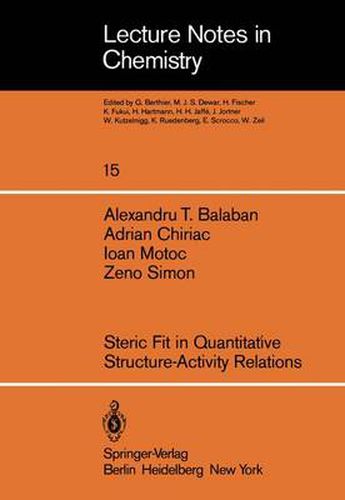Readings Newsletter
Become a Readings Member to make your shopping experience even easier.
Sign in or sign up for free!
You’re not far away from qualifying for FREE standard shipping within Australia
You’ve qualified for FREE standard shipping within Australia
The cart is loading…






This title is printed to order. This book may have been self-published. If so, we cannot guarantee the quality of the content. In the main most books will have gone through the editing process however some may not. We therefore suggest that you be aware of this before ordering this book. If in doubt check either the author or publisher’s details as we are unable to accept any returns unless they are faulty. Please contact us if you have any questions.
Although the importance of steric fit for receptor-effector 1 interactions was recognized since Emil Fischer proposed his lock and key theory, the whole area of steric properties is still in a very 2-4 early stage of development. We have a fairly good idea about el- tronic and hydrophobic parameters, but it is not easy to describe ste- ric shapes of molecules without a large number of data. There are se- veral cases of good QSAR’s developed for rather large series of mole- 5 cules without steric parameters - for example see papers by Hansch , 6 or Franke , but the state of steric parameters is nevertheless one of the most important drawbacks, especially concerning the ability of en- compassing, within a single QSAR, molecules of different shapes and stereoisomers. From today’s steric parameters, one may mention the 7 Taft parameters E ‘ which gave good results in organic chemistry, the S 8 10 ra th er cum b ersome way 0 f measurIng * s h ape d'ff I ere h ces 0 f Amoore - and , 11 12 AllInger ,and the L, B -B parameters of Verloop 1 4 The work described here consists of two types of approaches to the steric fit problem. The first approach consists of developing new parameters to describe different characteristics of the molecular shape (i. e. , branching, bulkiness); this is done by means of topological in- dices.
$9.00 standard shipping within Australia
FREE standard shipping within Australia for orders over $100.00
Express & International shipping calculated at checkout
Stock availability can be subject to change without notice. We recommend calling the shop or contacting our online team to check availability of low stock items. Please see our Shopping Online page for more details.
This title is printed to order. This book may have been self-published. If so, we cannot guarantee the quality of the content. In the main most books will have gone through the editing process however some may not. We therefore suggest that you be aware of this before ordering this book. If in doubt check either the author or publisher’s details as we are unable to accept any returns unless they are faulty. Please contact us if you have any questions.
Although the importance of steric fit for receptor-effector 1 interactions was recognized since Emil Fischer proposed his lock and key theory, the whole area of steric properties is still in a very 2-4 early stage of development. We have a fairly good idea about el- tronic and hydrophobic parameters, but it is not easy to describe ste- ric shapes of molecules without a large number of data. There are se- veral cases of good QSAR’s developed for rather large series of mole- 5 cules without steric parameters - for example see papers by Hansch , 6 or Franke , but the state of steric parameters is nevertheless one of the most important drawbacks, especially concerning the ability of en- compassing, within a single QSAR, molecules of different shapes and stereoisomers. From today’s steric parameters, one may mention the 7 Taft parameters E ‘ which gave good results in organic chemistry, the S 8 10 ra th er cum b ersome way 0 f measurIng * s h ape d'ff I ere h ces 0 f Amoore - and , 11 12 AllInger ,and the L, B -B parameters of Verloop 1 4 The work described here consists of two types of approaches to the steric fit problem. The first approach consists of developing new parameters to describe different characteristics of the molecular shape (i. e. , branching, bulkiness); this is done by means of topological in- dices.